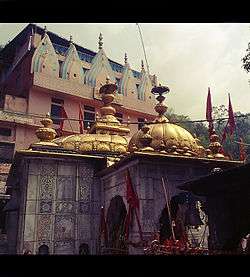Hindu genealogy registers at Jawalamukhi, Himachal Pradesh
| Jawalamukhi जवालामुखी Jawalaji | |
|---|---|
| city | |
 | |
 Jawalamukhi  Jawalamukhi Location in Himachal Pradesh, India | |
| Coordinates: 31°53′N 76°19′E / 31.88°N 76.32°ECoordinates: 31°53′N 76°19′E / 31.88°N 76.32°E | |
| Country |
|
| State | Himachal Pradesh |
| District | Kangra |
| Elevation | 610 m (2,000 ft) |
| Population (2011) | |
| • Total | 5,361 |
| Languages | |
| • Official | Hindi |
| Time zone | IST (UTC+5:30) |
Jawalamukhi is a Shakti peetha town and a nagar parishad in Kangra district in the Indian state of Himachal Pradesh. It is a site for Hindu pilgrimage. It soon also became customary for the family pandits (priest) to record each visit of the family, along with their gotra, family tree, marriages and members present etc., grouped according to family and home town. And over the centuries, these registers became an important genealogical source for many families, part of splintered families, in tracing their family tree and family history.
Genealogy Records
In India, Charans are the Bards who traditionally keep the written genealogy records of various castes. Some notable places where traditional genealogy records are kept include: Hindu genealogy registers at Kurukshetra, Haryana; Hindu genealogy registers at Peohwa, Haryana; Hindu genealogy registers at Haridwar (largest genealogy registers in north India); Hindu genealogy registers at Chintpurni, Himachal Pradesh; Hindu genealogy registers at Varanasi and Hindu genealogy registers at Trimbakeshwar, Maharashtra. This custom is similar to Panjis or Panji Prabandh, the extensive genealogical records maintained among Maithil Brahmins in Bihar.
Genealogy registers, of families, maintained by Brahmin Pandits (Priests) or ‘Pandas’, who double up as professional genealogists, has been a subject of study for many years now.[1][2] In several cases, these voluminous records or Vahis (Bahi), have also been used in settling legal cases regarding inheritance or property disputes, as these records are held sacrosanct both by the pilgrims and the Pandas themselves,[1] and in many places these records trace family history, for over twenty prior generations, stretching across many centuries.[3][4]
Records on Microfilm
Starting around 1977,[3] Hindu genealogy records were microfilmed, and later housed at the Genealogical Society of Utah (GSU), USA since 1981, other places in these records having records of Hindu families are Kurukshetra, Pehowa, Chintpurni, Jawalapur, and Jawalamukhi [5][6][7] The Genealogical Society of Utah currently restricts online access to the Hindu genealogy records to members of The Church of Jesus Christ of Latter-day Saints (LDS Church).
See also
References
- 1 2 Brahman pandas Divine Enterprise: Gurus and the Hindu Nationalist Movement, by Lise McKean, University of Chicago Press, 1996. ISBN 0-226-56010-4. Page 151.
- ↑ Janasakhi Janamsakhis of Miharban and Mani Singh, Janamsakhi Tradition, Dr. Kirpal Singh, 2004, Punjabi University, Patiala. ISBN 81-7205-311-8. www.globalsikhstudies.net.page 169.
- 1 2 Reporter at Large, The Mountain of Names The New Yorker, 13 May 1985.
- ↑ Shoumatoff, Alex (13 May 1985). "The mountain of names". The New Yorker. p. 51.
- ↑ India Genealogical Society of Utah.
- ↑ Tracing your Asian roots www.overseasindian.in.
- ↑ Hindu Pilgrimage Marriage Records www.movinghere.org.uk.
Further reading
- The Hindu world: an encyclopedic survey of Hinduism, by Benjamin Walker, Published by Praeger, 1968.
External links
![]() Media related to Family trees at Wikimedia Commons
Media related to Family trees at Wikimedia Commons
![]() Media related to Haridwar at Wikimedia Commons
Media related to Haridwar at Wikimedia Commons